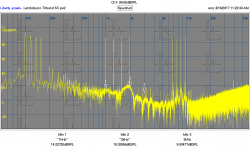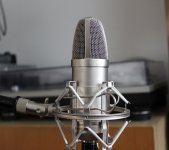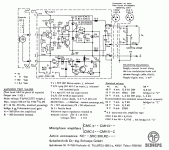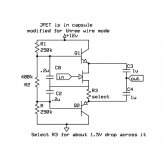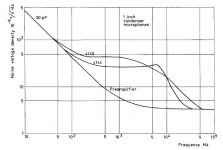- my issue, if it isnt clear by now... is to drive the speaker under test at realistic operating levels AND have a mic that wont over load or produce high distortion with that spkr drive. And, in my room, Scott is correct... I could measure spkr distortion at 10W and not over load the mic.
BUT, what is the distortion of a microphone at less than max spec spl? If it is 0.1% or less we are good to go.
The B&K paper I put up indicates it is much higher than I might have guessed at less than max rated spl... Too high in fact.
Back to... can we measure mics and find out ourselves or is there published thd specs at various spl levels for a mic/preamp somewhere which meets our spl/low thd needs? Which mic/pre would that be?
THx-RNMarsh
You may also find it is a distortion pattern, not random (I doubt it is random) and that...you might be able to do something with.
Of course, this would require measuring the surface of the microphone with a reflected laser and at the same time, recording the signal from the microphone and looking for the pattern as a comparison. And then you might be able to build an algorithm that nulls it out, well enough to be useful in some way.
building up and honing this method with large diaphragm microphones could possibly lead to a magnitude better level of distortion as a measurement and in that apparent accuracy, re the hard numbers.
Not what the microphone is doing per se (re recording music), but what the algorithms do with it. Measure in multiple spots to understand the origins of the pattern, specific types of patterns based on capsule models and then the specifics of the calibration algorithm for distortion for the individual microphone in hand.
This can go in many directions. Improving microphones and so on.
Last edited:
With each passing year it sinks in more deeply that the more music I can appreciate the more I appreciate music. This does not extend to Miley Cyrus tho 😛
Nothing wrong with a bit of Miley !
YouTube
Back to distortion measurements of microphones. This is in effect a measurement of microphone distortion. Its a Lambda pro headphone on a custom test fixture (flat 3/4" plex plate) with a "toy" Panasonic wm-61 microphone. Its a spectral contamination plot at approx 100 dBSPL with three groups of tones in three bands selected so no harmonic or IM product will overlap a tone.
This is a high res FFT which is why there is good resolution into the noise.
You can see on the middle set the harmonics are approx 70 dB down. The IM products on the HF are around 60 dB down. Worst case is the LF harmonics at around 40 dB down.
1) The Lambda pro is a very low distortion source
2) The Panasonic microphone seems to keep up just fine.
3) LF distortion is a more difficult problem than HF distortion.
4) ?? does the diaphragm of a microphone need to move more for low frequencies like a speaker?? Could that relate to the LF distortion?
I don't have access to the Lambda pro so I can't do more measurements right now or try it with any of the B&K's or the Gras I have. And I suspect after this I'll never be able to buy one.
This is a high res FFT which is why there is good resolution into the noise.
You can see on the middle set the harmonics are approx 70 dB down. The IM products on the HF are around 60 dB down. Worst case is the LF harmonics at around 40 dB down.
1) The Lambda pro is a very low distortion source
2) The Panasonic microphone seems to keep up just fine.
3) LF distortion is a more difficult problem than HF distortion.
4) ?? does the diaphragm of a microphone need to move more for low frequencies like a speaker?? Could that relate to the LF distortion?
I don't have access to the Lambda pro so I can't do more measurements right now or try it with any of the B&K's or the Gras I have. And I suspect after this I'll never be able to buy one.
Attachments
But, you didnt tell me the mic you used. How did you measure mic distortion? 102 near field could be 100 mW of power. This is the fundamental issue with near field... small signal distortion -- well below "normal" listening speaker drive power. Because speaker distortion increases with cone displacement and driving power... the distortion data from near field is very misleading at best for most people listening in far field. ... at least for audible issues.
On the other hand, if you listen in near field, as I suggest.... you can get some very good sound from your speakers; both distortion-wise and room interference-wise.
THx-RNMarsh
I think the topic now was to measure microphone distortion. The method I used measures at about 100dB SPL and it shows both IM and HD distortion is 0.02 - 0.03%. This is the only relevant output, to me, I know that for SPL <=100dB I do not need to bother with microphone distortion when measuring in a listening position. I do not have more than 100dB SPL at my listening place when I listen to the music. All else is irrelevant, IMO.
4) ?? does the diaphragm of a microphone need to move more for low frequencies like a speaker?? Could that relate to the LF distortion?
Depends (IMO) if it is a pressure microphone or velocity microphone. Also depends on principle, dynamic/condenser.
I think the topic now was to measure microphone distortion. The method I used measures at about 100dB SPL and it shows both IM and HD distortion is 0.02 - 0.03%. This is the only relevant output, to me, I know that for SPL <=100dB I do not need to bother with microphone distortion when measuring in a listening position. I do not have more than 100dB SPL at my listening place when I listen to the music. All else is irrelevant, IMO.
That is good to know such a mic exists. Now then... are you going to tell us what you use or not?
OR your method which is able to know distortion from Mic is that low.
??
-THx RNMarsh
Last edited:
Once again re diaphragm excursion, quoted from Shure:
Can a dynamic microphone handle really loud sounds? (Maximum SPL) | Knowledge Base | Shure Americas
Can a dynamic microphone handle really loud sounds? (Maximum SPL) | Knowledge Base | Shure Americas
Unlike a condenser microphone which has internal electronics that may overload, a dynamic microphone distorts when its diaphragm hits a physical barrier, like the magnetic pole piece, and can move no further. The excursion of the diaphragm is frequency dependent and the excursion is greatest at the resonant frequency of the diaphragm. Therefore, the MAX SPL of a dynamic microphone like the SM58 is frequency dependent. This means that low frequencies will produce distortion at a lower SPL than higher frequencies.
That is good to know such a mic exists. Now then... are you going to tell us what you use or not?
OR your method which is able to know distortion from Mic is that low.
??
-THx RNMarsh
The microphone is quite a usual 1" condenser type, with K67 large 34mm capsule and Schoeps interface circuit. I am not sure if every piece has the same distortion parameters so I am not giving the type. No distortion cancellation method has been used.
Attachments
In the german thesis Jakob linked to a few pages back (post 12490 iirc) it was found that neither the diaphragm nor the electric circuit (when properly done) are major distortion contributers in measurement mics (1/2" class, onmi). The air cavities, both directly behind the membrane and the larger one behind the perforated back-plate have been found to have the strongest influence, not what the author expected. Smaller is better wrt distortion (distortion goes with volume squared).1) The Lambda pro is a very low distortion source
2) The Panasonic microphone seems to keep up just fine.
3) LF distortion is a more difficult problem than HF distortion.
4) ?? does the diaphragm of a microphone need to move more for low frequencies like a speaker?? Could that relate to the LF distortion?
This would suggest the small 1/4" back-electrets ain't that bad for this exact reason. I've ordered some Transsound 1/4" and 1/2" electret capsules to see how they differ wrt distortion (as per two-sources IMD test).
This would suggest the small 1/4" back-electrets ain't that bad for this exact reason. I've ordered some Transsound 1/4" and 1/2" electret capsules to see how they differ wrt distortion (as per two-sources IMD test).
Don't get the ones with the built in FET if you want to build the Schoeps type circuit. Follow the original circuit (the trim is required to cancel 2nd's) using a small low Cgd FET like a 2SK118. Try to use a 5G rather than 1G bias resistor too. There is a picture of the null working in my LA article electrically measured you can get almost -90dB, the acoustic null would depend on the phase of the seconds from the capsule.
If you have a capsule with built-in FET the simple circuit on the right works remarkably well. You can use any high beta lowish noise bipolars like from the BC series and there are some howto's on the web for doing the Linkwitz mod without destroying a few capsules (Transsound might have some 3 wire versions). If you missed my warning their schematics are misleading and you can't always tell if there is a FET or not.
EDIT - Not shown is the third wire (case) it is grounded.
Attachments
Last edited:
In the german thesis Jakob linked to a few pages back (post 12490 iirc) it was found that neither the diaphragm nor the electric circuit (when properly done) are major distortion contributers in measurement mics (1/2" class, onmi).
This thesis (a couple of B&K staff members are on the committee) says the opposite but I can't read much of the other one. I would think playing with the acoustic loading would change frequency response and sensitivity? Is that discussed?
https://pdfs.semanticscholar.org/e9f8/5980d82b1d8f9bcc2574e38f0c1ef162d07d.pdf
Yes, it is stated sensitivity goes down with lower chamber volume and response is skewed and hence there is compromise to be found.would think playing with the acoustic loading would change frequency response and sensitivity? Is that discussed?
As for the capsules, I took TSB-140AO (3-terminal) and TS-60A (two-terminal but easy to mod), both seem to have JFETs built in. Thanks for the circuits, especially that of yours on the right with the clever bootstrapping BJTs doubling up as buffers, I'll definitely give it a try (have tons of hfe-matched and noise-tested BC550's and 560's).
Last edited:
I have a few TSB165a's which are quite popular with DIY'ers in the Schoeps circuit. You can tape two face to face and couple the front chambers together and observe the Brownian noise without any room noise incursion.
Keith Johnson suggested to me putting the microphones in a vacuum to see the real noise floor. No air to excite the diaphragms.
Very odd. My vacuum is very noisy. I guess if I take the bag out, disconnect the hose and run the wire out the hole, I could test it..Keith Johnson suggested to me putting the microphones in a vacuum to see the real noise floor. No air to excite the diaphragms.
But there is certainly a lot of air in there, perhaps his vacuum is broken?😀
Granted, the question of mic distortion products is important for absolutes, but to determine if a specific fb mechanism helps, I would think just repeating the test with only the driver wiring changed would be a good first "contact".
jn
ps...sigh...doin a gig tomorrow, 8 mics, all the speakers are over 75 years of age, little if any experience talking into a mic, in a room that is so live that it takes over a second for a handclap to go away, all sitting on one end of the room with their backs to a 25 foot by 15 foot wall of glass and hard surface (think acoustic mirror), and those in charge refused to allow me to put a backdrop behind them to absorb reflections.
What could possibly go wrong...😱😱
Last edited:
Keith Johnson suggested to me putting the microphones in a vacuum to see the real noise floor. No air to excite the diaphragms.
Substituting a C for the capsule capacitance does the same, you would think turning off the bias would work but I found mics that had residual charge on their diaphragms after the bias was removed even after a long time. This plot from B&K should dispel some myths about FET swapping and improving the preamp noise floor (the noise only gets worse for smaller capsules). The low frequency trend line is just the 1G resistor and 50pF rolloff of the 1000nV of the resistor.
Attachments
Last edited:
I guess we can use this. Another file on this method is here
Microphone Intermodulation Distortion Measurement – Listen, Inc.
THx-RNMarsh
Microphone Intermodulation Distortion Measurement – Listen, Inc.
THx-RNMarsh
Hi everybody, is everyone now up to date on measurement microphones now? I hope so, because I would like to see some progress in the speaker measurement here. I guess we all would, but we have gotten bogged down in measurements. It isn't THAT HARD. But you have to use real measurement microphones that have been designed for the purpose, or if you use something different, then you have to compare what you want to measure with to a measurement mike, to be sure it will not distort too much. Many studio mikes will work sort of OK, so long as you don't stress them too much. Absolute values of distortion are not as important as are RELATIVE measurements in distortion between different speaker drives.
Last edited:
- Status
- Not open for further replies.
- Home
- Member Areas
- The Lounge
- John Curl's Blowtorch preamplifier part III
